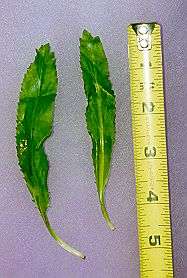Eryngium foetidum
Eryngium foetidum is a tropical perennial herb in the family Apiaceae. Common names include culantro (/kuːˈlɑːntroʊ/ or /kuːˈlæntroʊ/), recao, shadow beni, Mexican coriander, bhandhania, long coriander, sawtooth coriander, and ngò gai.[2][3] It is native to Mexico, the Caribbean, Central and South America, but is cultivated worldwide, sometimes being grown as an annual in temperate climates.
| Culantro | |
|---|---|
 | |
| Eryngium foetidum leaves | |
| Scientific classification | |
| Kingdom: | |
| (unranked): | |
| (unranked): | |
| (unranked): | |
| Order: | |
| Family: | |
| Genus: | |
| Species: | E. foetidum |
| Binomial name | |
| Eryngium foetidum | |
| Synonyms[1] | |
| |
In the United States, the common name culantro sometimes causes confusion with cilantro, a common name for the leaves of Coriandrum sativum (also in Apiaceae), of which culantro is said to taste like a stronger version.[4]
Uses

Culinary
E. foetidum is widely used in seasoning, marinating and garnishing in the Caribbean, particularly in Cuba, Dominican Republic, Puerto Rico, Trinidad and Tobago, Panama, Guyana, Suriname, and in Ecuador and Peru's Amazon regions. It is used extensively in Cambodia, Thailand, India, Vietnam, Laos, Myanmar and other parts of Asia as a culinary herb.[5] It dries well, retaining good color and flavor, making it valuable in the dried herb industry. It is sometimes used as a substitute for coriander, but it has a much stronger taste.
In the United States, E. foetidum grows naturally in Florida, Georgia, Hawaii, Puerto Rico, and the Virgin Islands.[6]
Traditional medicine
E. foetidum has been used in traditional medicine in tropical regions for burns, earache, fevers, hypertension, constipation, fits, asthma, stomachache, worms, infertility complications, snake bites, diarrhea, and malaria.[7]
E. foetidum is also known as E. antihystericum.[8] The specific name antihystericum reflects the fact that this plant has traditionally been used for epilepsy.[9] The plant is said to calm a person's 'spirit' and thus prevents epileptic 'fits', so is known by the common names spiritweed and fitweed. The anticonvulsant properties of this plant have been scientifically investigated.[10] A decoction of the leaves has been shown to exhibit anti-inflammatory and analgesic effects in rats.[11]
Eryngial is a chemical compound isolated from E. foetidum.[12] The University of the West Indies at Mona, Jamaica, has investigated the use of enyngial as a treatment for human Strongyloides stercoralis infection (strongyloidiasis).
It is used as an ethnomedicinal plant for the treatment of a number of ailments such as fevers, chills, vomiting, burns, fevers, hypertension, headache, earache, stomachache, asthma, arthritis, snake bites, scorpion stings, diarrhea, malaria and epilepsy. The main constituent of essential oil of the plant is eryngial (E-2-dodecenal). A pharmacological investigation claims to have demonstrated anthelmintic, anti-inflammatory, analgesic, anticonvulsant, anticlastogenic, anticarcinogenic, antidiabetic, and antibacterial activity.[13]
See also
- Cuban cuisine
- Cuisine of the Dominican Republic
- List of culinary herbs and spices
- Mizo cuisine
- Puerto Rican cuisine
- Thai cuisine
- Trinidad and Tobago cuisine
- Vietnamese cuisine
References
- "The Plant List: A Working List of All Plant Species". Retrieved 1 October 2015.
- "Eryngium foetidum". Germplasm Resources Information Network (GRIN). Agricultural Research Service (ARS), United States Department of Agriculture (USDA). Retrieved 21 January 2018.
- "Culantro". WorldCrops. Retrieved 5 February 2019.
- Ramcharan, C. (1999). "Culantro: A much utilized, little understood herb". In: J. Janick (ed.), Perspectives on new crops and new uses. ASHS Press, Alexandria, Virginia; p. 506–509.
- Singh BK, Ramakrishna Y and Ngachan SV. 2014. Spiny coriander (Eryngium foetidum L.): A commonly used, neglected spicing-culinary herb of Mizoram, India. Genetic Resources and Crop Evolution 61 (6): 1085-1090.
- Distribution of Eryngium foetidum in the United States United States Department of Agriculture
- Paul J.H.A.; Seaforth C.E.; Tikasingh T. (2011). "Eryngium foetidum L.: A review". Fitoterapia. 82 (3): 302–308. doi:10.1016/j.fitote.2010.11.010. PMID 21062639.
- "Atlas of Florida Vascular Plants".
- Culantro. "Herbalpedia" (PDF). The Herb Growing & Marketing Network.
- Simon, OR; Singh, N (1986). "Demonstration of anticonvulsant properties of an aqueous extract of Spirit Weed (Eryngium foetidum L.)". The West Indian Medical Journal. 35 (2): 121–5. PMID 3739342.
- Sáenz, M. T.; Fernández, M. A.; García, M. D. (1997). "Antiinflammatory and analgesic properties from leaves ofEryngium foetidum L. (Apiaceae)". Phytotherapy Research. 11 (5): 380. doi:10.1002/(SICI)1099-1573(199708)11:5<380::AID-PTR116>3.0.CO;2-#.
- Yarnell, A. "Home Field Advantage" Chemical & Engineering News, June 7, 2004. Volume 82, Number 23, p. 33.
- Singh BK, Ramakrishna Y and Ngachan SV. 2014. Spiny coriander (Eryngium foetidum L.): A commonly used, neglected spicing-culinary herb of Mizoram, India. Genetic Resources and Crop Evolution 61 (6): 1085-1090
External links
| Wikimedia Commons has media related to Eryngium foetidum. |
- Long coriander (Eryngium foetidum L.) page from Gernot Katzer's Spice Pages